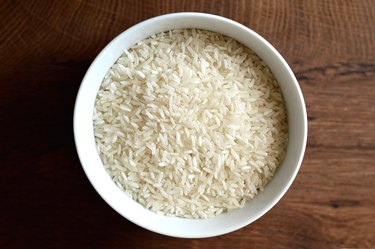
An infestation of bugs in rice in your pantry can be quite alarming, and gross, but isn't harmful to your health. Of course, you want to avoid getting bugs in rice in the first place with proper storage.
Tip
Avoid having bugs in rice found in your pantry by inspecting all grains purchased closely, and discarding any infested foods. A thorough cleaning of your pantry, and a wipe down of the shelves with white vinegar, also helps.
Video of the Day
A Common Problem
Weevils infect rice and other grains regularly. They use the grains for nourishment and to house their eggs. According to research published in Insect Biochemistry and Molecular Biology in April 2016, it's likely that the weevils use the pectin in rice for energy.
Video of the Day
Female weevils use grains, such as rice, as a place to lay an egg. Each bug can do this up to 254 times. The egg lives in the grain kernel, eating the nutrients, for a few months, and then hatches. It then looks for a mate, lays more eggs and finds new grains to use for an incubator.
For this reason, infestations of bugs in rice can be hard to eradicate. The individual grains become compromised.
Warning
You definitely do NOT want a professional exterminator or chemical treatments for bugs in rice. These high-powered insecticides should not be used in or around foods, or sprayed in areas where food will be stored. Use a home remedy for rice weevil eradication.
Prevent Bugs in Rice
Before bringing any rice or other grains into your pantry, inspect them thoroughly to make sure you see no bugs — not even one. When you get the grains home, freeze them for at least one week to kill any eggs. If you have space, store them in the freezer until use.
Discard any grains that may have an infestation. Grain weevils can bore through cardboard and plastic. If you have found grain weevils in rice or other grains, you should get rid of all grains that aren't stored properly.
Store rice, and all other grains, in tightly sealed containers made of metal, sturdy plastic or glass. Weevils and other grain bugs can chew their way through plastic bags and cardboard boxes.
Clean your pantry shelves, including any cracks and crevices, regularly. Vacuum the area, too. Wipe the area down with white vinegar, a safe cleaner that repels the bugs but isn't harmful to humans.
Eliminate Existing Bugs in Rice
If you do find weevils in your rice, discard the product immediately. Examine other grains in your pantry, as well as seeds, nuts, dried beans, cereals and dried corn. If they have traces of bugs, your best choice is to throw them out as well. This helps eradicate your infestation.
If you want to kill the weevils, rather than getting rid of the food, it is possible to destroy the bugs, their eggs and their pupae and larvae. Freeze the product at 0 degrees Fahrenheit for three days, or heat the product to 140 degrees Fahrenheit for one to two hours. Make sure the food can withstand heat; for example, not all nuts and seeds can maintain this temperature.
When you have cleaned a pantry that's been infested, discard the bags containing anything that might have weevils in it outside — away from the house. If you've discovered weevils after you've eaten your rice meal, don't panic. Bugs found in rice aren't poisonous. Eating one or two, or their eggs and larvae, won't hurt you — it just may make you a bit squeamish.